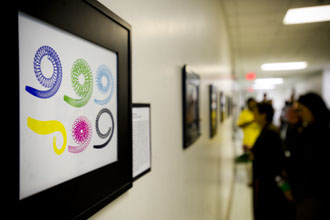Art, Science and Math Converge in Show
The waning light of November is slanting through the windows of Stanley Thomas Hall. Upstairs, on the fourth floor, amid the civilized sounds of quiet chitchat and the clinking of glassware, a genial convergence of science and art is getting under way. For the third year, the Center for Computational Science is holding an art show comprised of images produced by the center's students, researchers and faculty.

The colorful curls in this computer-generated artwork by Sarah Olson, a postdoctoral researcher in the mathematics department, represent the motility of sperm impacted by different chemical cues. (Photo by Paula Burch-Celentano)
The show, which was held on Tuesday (Nov. 30), is an event through which the campus community can view and learn about the work taking place at the center, says Ricardo Cortez, director.
“It's easy for us to share what we do with people who understand the science but not so easy with those who are not in science,” he says.
The science, or at least its graphical representation, is displayed in a number of neatly displayed pieces that stretch along either side of one corridor. The computer-generated works illustrate research currently taking place at the center and span the fields of physics, genetics, biology, physiology and engineering.
“Peristaltic Particle Pumping,” is the title given to a piece produced by postdoctoral researcher John Chrispell. With its figure-eight swirls and overlay of color, the piece is handsome and strangely hypnotic.
Chrispell regards the work with the cool objectivity of a scientist. “We tried to make it pretty,” he says. “The image itself is nice and so is the mathematics that go behind it.”
A dean here, a vice president there, students, staff and faculty everywhere, the attendees cluster in small groups around various pieces. They salute the works by holding small plates of food and glasses of wine chest high, considering the art, the comestibles and the pleasure of each other's company.
